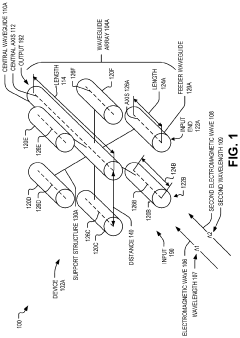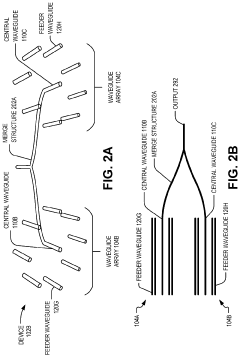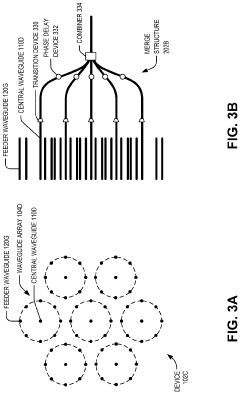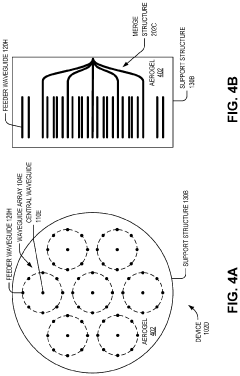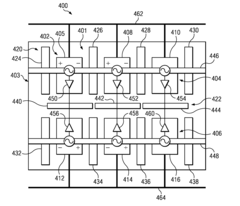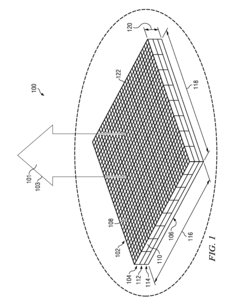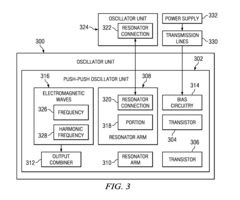Strategic Use of Electromagnetic Waves in Defense Applications
JUL 11, 20259 MIN READ
Generate Your Research Report Instantly with AI Agent
Patsnap Eureka helps you evaluate technical feasibility & market potential.
EM Wave Defense Evolution
The strategic use of electromagnetic waves in defense applications has undergone significant evolution since its inception. Initially, radar systems were the primary focus, with early developments dating back to the 1930s. These systems utilized radio waves to detect and track enemy aircraft, ships, and other military assets. As technology progressed, the applications of electromagnetic waves in defense expanded rapidly.
During the Cold War era, electronic warfare became a critical component of military strategy. This period saw the development of sophisticated jamming techniques to disrupt enemy communications and radar systems. Concurrently, countermeasures were developed to protect against such attacks, leading to an ongoing cycle of innovation in electromagnetic warfare.
The advent of stealth technology in the 1970s and 1980s marked a significant milestone in the evolution of electromagnetic wave defense. By designing aircraft and ships to minimize their radar cross-section, military forces could reduce their detectability, fundamentally changing the dynamics of warfare and defense strategies.
In the 1990s and early 2000s, the focus shifted towards network-centric warfare, where electromagnetic waves played a crucial role in creating interconnected battlefield systems. This era saw the integration of various sensors, communication systems, and weapons platforms, all relying on the electromagnetic spectrum for data transmission and coordination.
More recently, the rise of directed energy weapons has opened new frontiers in electromagnetic wave defense. High-power microwave weapons and laser systems have the potential to disable electronic systems or destroy targets with unprecedented precision and speed. These technologies represent a significant departure from traditional kinetic weapons and are reshaping military doctrine.
The miniaturization of electronic components and the advent of nanotechnology have also influenced the evolution of electromagnetic wave defense. These advancements have led to the development of smaller, more efficient sensors and communication devices, enhancing situational awareness and battlefield coordination.
In the current landscape, the focus has shifted towards spectrum management and electromagnetic spectrum operations (EMSO). With the increasing reliance on wireless technologies in both civilian and military domains, the ability to control and exploit the electromagnetic spectrum has become a critical strategic asset. This has led to the development of advanced electronic warfare suites, cognitive radio systems, and adaptive signal processing techniques.
Looking ahead, the integration of artificial intelligence and machine learning into electromagnetic wave defense systems promises to revolutionize the field further. These technologies will enable more adaptive and responsive defense systems, capable of autonomously detecting, classifying, and countering electromagnetic threats in real-time.
During the Cold War era, electronic warfare became a critical component of military strategy. This period saw the development of sophisticated jamming techniques to disrupt enemy communications and radar systems. Concurrently, countermeasures were developed to protect against such attacks, leading to an ongoing cycle of innovation in electromagnetic warfare.
The advent of stealth technology in the 1970s and 1980s marked a significant milestone in the evolution of electromagnetic wave defense. By designing aircraft and ships to minimize their radar cross-section, military forces could reduce their detectability, fundamentally changing the dynamics of warfare and defense strategies.
In the 1990s and early 2000s, the focus shifted towards network-centric warfare, where electromagnetic waves played a crucial role in creating interconnected battlefield systems. This era saw the integration of various sensors, communication systems, and weapons platforms, all relying on the electromagnetic spectrum for data transmission and coordination.
More recently, the rise of directed energy weapons has opened new frontiers in electromagnetic wave defense. High-power microwave weapons and laser systems have the potential to disable electronic systems or destroy targets with unprecedented precision and speed. These technologies represent a significant departure from traditional kinetic weapons and are reshaping military doctrine.
The miniaturization of electronic components and the advent of nanotechnology have also influenced the evolution of electromagnetic wave defense. These advancements have led to the development of smaller, more efficient sensors and communication devices, enhancing situational awareness and battlefield coordination.
In the current landscape, the focus has shifted towards spectrum management and electromagnetic spectrum operations (EMSO). With the increasing reliance on wireless technologies in both civilian and military domains, the ability to control and exploit the electromagnetic spectrum has become a critical strategic asset. This has led to the development of advanced electronic warfare suites, cognitive radio systems, and adaptive signal processing techniques.
Looking ahead, the integration of artificial intelligence and machine learning into electromagnetic wave defense systems promises to revolutionize the field further. These technologies will enable more adaptive and responsive defense systems, capable of autonomously detecting, classifying, and countering electromagnetic threats in real-time.
Military EM Demand Analysis
The strategic use of electromagnetic waves in defense applications has become increasingly critical in modern warfare, driving a surge in demand for advanced electromagnetic (EM) technologies within the military sector. This demand is primarily fueled by the need for enhanced situational awareness, improved communication capabilities, and more effective electronic warfare systems.
In recent years, military organizations worldwide have significantly increased their investments in EM-based technologies. This trend is evident in the growing budgets allocated to research and development of radar systems, electronic countermeasures, and directed energy weapons. The global military radar market, a key component of EM applications in defense, is projected to experience substantial growth in the coming years.
One of the primary drivers of military EM demand is the evolving nature of modern conflicts. As warfare becomes increasingly network-centric and information-driven, the ability to control and manipulate the electromagnetic spectrum has become a crucial factor in gaining tactical advantages. This has led to a heightened focus on developing and deploying advanced electronic warfare (EW) systems, which rely heavily on EM technologies.
The demand for EM technologies in military applications extends beyond traditional combat scenarios. There is a growing need for electromagnetic pulse (EMP) protection systems to safeguard critical infrastructure and military assets against potential EMP attacks. This has spurred research into hardening technologies and protective measures against electromagnetic threats.
Furthermore, the rise of unmanned aerial vehicles (UAVs) and autonomous systems has created new opportunities and challenges in the realm of EM applications. Military organizations are investing in advanced radar and sensor technologies to detect, track, and potentially neutralize these emerging threats, further driving the demand for innovative EM solutions.
In the naval domain, there is an increasing focus on developing advanced sonar systems and underwater communication technologies that leverage electromagnetic principles. These advancements are crucial for improving submarine detection capabilities and enhancing underwater situational awareness.
The space domain has also become a significant area of interest for military EM applications. As space-based assets become increasingly vital for military operations, there is a growing demand for technologies that can protect satellites from electromagnetic interference and potential attacks.
As geopolitical tensions continue to rise in various regions, many nations are prioritizing the development of indigenous EM capabilities to reduce dependence on foreign technologies. This trend is likely to further stimulate research and development efforts in the field of military EM applications, leading to increased innovation and market growth.
In recent years, military organizations worldwide have significantly increased their investments in EM-based technologies. This trend is evident in the growing budgets allocated to research and development of radar systems, electronic countermeasures, and directed energy weapons. The global military radar market, a key component of EM applications in defense, is projected to experience substantial growth in the coming years.
One of the primary drivers of military EM demand is the evolving nature of modern conflicts. As warfare becomes increasingly network-centric and information-driven, the ability to control and manipulate the electromagnetic spectrum has become a crucial factor in gaining tactical advantages. This has led to a heightened focus on developing and deploying advanced electronic warfare (EW) systems, which rely heavily on EM technologies.
The demand for EM technologies in military applications extends beyond traditional combat scenarios. There is a growing need for electromagnetic pulse (EMP) protection systems to safeguard critical infrastructure and military assets against potential EMP attacks. This has spurred research into hardening technologies and protective measures against electromagnetic threats.
Furthermore, the rise of unmanned aerial vehicles (UAVs) and autonomous systems has created new opportunities and challenges in the realm of EM applications. Military organizations are investing in advanced radar and sensor technologies to detect, track, and potentially neutralize these emerging threats, further driving the demand for innovative EM solutions.
In the naval domain, there is an increasing focus on developing advanced sonar systems and underwater communication technologies that leverage electromagnetic principles. These advancements are crucial for improving submarine detection capabilities and enhancing underwater situational awareness.
The space domain has also become a significant area of interest for military EM applications. As space-based assets become increasingly vital for military operations, there is a growing demand for technologies that can protect satellites from electromagnetic interference and potential attacks.
As geopolitical tensions continue to rise in various regions, many nations are prioritizing the development of indigenous EM capabilities to reduce dependence on foreign technologies. This trend is likely to further stimulate research and development efforts in the field of military EM applications, leading to increased innovation and market growth.
EM Defense Tech Challenges
The strategic use of electromagnetic waves in defense applications faces several significant challenges that require innovative solutions and ongoing research. One of the primary obstacles is the increasing complexity of the electromagnetic environment, which has become saturated with various signals from both civilian and military sources. This signal congestion makes it difficult to detect, identify, and track potential threats accurately.
Another major challenge is the development of effective countermeasures against advanced electronic warfare techniques. As adversaries continue to improve their capabilities in jamming, spoofing, and other forms of electromagnetic interference, defense systems must evolve to maintain their effectiveness. This includes developing more robust and adaptive systems that can operate in contested electromagnetic environments.
The miniaturization and integration of electromagnetic systems pose additional technical hurdles. There is a growing need for compact, lightweight, and energy-efficient devices that can be deployed on various platforms, from handheld units to unmanned aerial vehicles. This requires advancements in materials science, power management, and system integration.
Cybersecurity is an increasingly critical concern in electromagnetic defense applications. As these systems become more networked and software-dependent, they become vulnerable to cyber attacks. Ensuring the integrity and security of electromagnetic defense systems against both electronic and cyber threats is a complex and ongoing challenge.
The rapid pace of technological advancement in this field also presents challenges in terms of standardization and interoperability. Different systems and platforms must be able to communicate and work together seamlessly, which requires the development of common protocols and interfaces. This is particularly important in multinational defense operations where various countries' systems need to integrate effectively.
Furthermore, there is a growing need for improved spectrum management and allocation. The electromagnetic spectrum is a finite resource, and the increasing demand for bandwidth from both military and civilian sectors necessitates more efficient use of available frequencies. This requires the development of advanced spectrum sharing technologies and dynamic spectrum access techniques.
Lastly, the ethical and legal implications of electromagnetic warfare present challenges in terms of policy and international agreements. The development and use of these technologies must be balanced with considerations of international law, human rights, and potential collateral effects on civilian infrastructure and populations.
Another major challenge is the development of effective countermeasures against advanced electronic warfare techniques. As adversaries continue to improve their capabilities in jamming, spoofing, and other forms of electromagnetic interference, defense systems must evolve to maintain their effectiveness. This includes developing more robust and adaptive systems that can operate in contested electromagnetic environments.
The miniaturization and integration of electromagnetic systems pose additional technical hurdles. There is a growing need for compact, lightweight, and energy-efficient devices that can be deployed on various platforms, from handheld units to unmanned aerial vehicles. This requires advancements in materials science, power management, and system integration.
Cybersecurity is an increasingly critical concern in electromagnetic defense applications. As these systems become more networked and software-dependent, they become vulnerable to cyber attacks. Ensuring the integrity and security of electromagnetic defense systems against both electronic and cyber threats is a complex and ongoing challenge.
The rapid pace of technological advancement in this field also presents challenges in terms of standardization and interoperability. Different systems and platforms must be able to communicate and work together seamlessly, which requires the development of common protocols and interfaces. This is particularly important in multinational defense operations where various countries' systems need to integrate effectively.
Furthermore, there is a growing need for improved spectrum management and allocation. The electromagnetic spectrum is a finite resource, and the increasing demand for bandwidth from both military and civilian sectors necessitates more efficient use of available frequencies. This requires the development of advanced spectrum sharing technologies and dynamic spectrum access techniques.
Lastly, the ethical and legal implications of electromagnetic warfare present challenges in terms of policy and international agreements. The development and use of these technologies must be balanced with considerations of international law, human rights, and potential collateral effects on civilian infrastructure and populations.
Current EM Defense Systems
01 Electromagnetic wave detection and measurement
Various devices and methods for detecting and measuring electromagnetic waves are described. These include sensors, antennas, and specialized equipment for analyzing wave characteristics such as frequency, amplitude, and phase. Applications range from scientific research to telecommunications and environmental monitoring.- Electromagnetic wave detection and measurement: Various devices and methods for detecting and measuring electromagnetic waves are described. These include sensors, antennas, and other specialized equipment designed to capture and analyze electromagnetic signals across different frequencies and intensities.
- Electromagnetic wave shielding and protection: Technologies for shielding and protecting against electromagnetic waves are presented. These include materials and structures designed to block or absorb electromagnetic radiation, as well as methods for reducing electromagnetic interference in electronic devices and systems.
- Electromagnetic wave generation and transmission: Systems and methods for generating and transmitting electromagnetic waves are discussed. This includes various types of transmitters, antennas, and other devices designed to produce and propagate electromagnetic signals for communication, sensing, or other applications.
- Electromagnetic wave applications in medical field: The use of electromagnetic waves in medical applications is explored. This includes diagnostic imaging techniques, therapeutic treatments, and monitoring systems that utilize various forms of electromagnetic radiation to improve healthcare outcomes.
- Electromagnetic wave-based communication systems: Advanced communication systems that utilize electromagnetic waves are presented. These include wireless networks, satellite communications, and other technologies that rely on the transmission and reception of electromagnetic signals to exchange information over long distances.
02 Electromagnetic wave shielding and absorption
Technologies for shielding against or absorbing electromagnetic waves are presented. These include materials and structures designed to protect sensitive equipment, reduce interference, or enhance signal quality. Applications span from consumer electronics to military and aerospace industries.Expand Specific Solutions03 Electromagnetic wave generation and transmission
Systems and methods for generating and transmitting electromagnetic waves are discussed. These encompass various types of transmitters, antennas, and wave guides designed for specific frequency ranges and applications. Uses include communication systems, radar, and medical imaging.Expand Specific Solutions04 Electromagnetic wave-based imaging and sensing
Applications of electromagnetic waves in imaging and sensing technologies are explored. This includes radar systems, medical imaging devices, and remote sensing equipment. These technologies utilize various parts of the electromagnetic spectrum for different purposes, such as security screening, geological surveys, and medical diagnostics.Expand Specific Solutions05 Electromagnetic wave energy harvesting and conversion
Methods and devices for harvesting and converting electromagnetic wave energy into usable forms are presented. This includes technologies for wireless power transmission, energy scavenging from ambient electromagnetic fields, and conversion of electromagnetic waves into other forms of energy such as heat or electricity.Expand Specific Solutions
Defense Industry Players
The strategic use of electromagnetic waves in defense applications is a rapidly evolving field with significant market potential. The industry is in a growth phase, driven by increasing global security concerns and technological advancements. The market size is substantial, with major defense contractors like Lockheed Martin, Boeing, and Raytheon leading the way. These companies are investing heavily in research and development to maintain their competitive edge. The technology's maturity varies across different applications, ranging from well-established radar systems to emerging directed energy weapons. Companies like BAE Systems and Northrop Grumman are also making significant strides in this domain, focusing on electronic warfare systems and advanced sensor technologies. As the field continues to evolve, collaboration between defense contractors, research institutions, and government agencies is becoming increasingly crucial for innovation and market growth.
Lockheed Martin Corp.
Technical Solution: Lockheed Martin has developed advanced electromagnetic warfare systems, including the AN/ALQ-249 Next Generation Jammer Mid-Band (NGJ-MB) for the U.S. Navy. This system uses active electronically scanned array (AESA) technology to deliver high-power jamming at greater distances[1]. The company also focuses on directed energy weapons, such as their High Energy Laser and Integrated Optical-dazzler with Surveillance (HELIOS) system, which combines high-energy lasers for offensive and defensive operations with long-range Intelligence, Surveillance, and Reconnaissance (ISR) capabilities[2]. Additionally, Lockheed Martin is working on advanced radar systems that utilize electromagnetic waves for detection and tracking, such as their Long Range Discrimination Radar (LRDR) for missile defense[3].
Strengths: Cutting-edge technology in electromagnetic warfare and directed energy weapons, strong integration capabilities with existing defense systems. Weaknesses: High development costs, potential for export restrictions due to sensitive technology.
BAE Systems Information & Electronic Sys Integration, Inc.
Technical Solution: BAE Systems has developed the Electronic Warfare System (EWS) for the F-35 Lightning II, which provides advanced situational awareness and electromagnetic spectrum dominance[8]. Their Digital Electronic Warfare System (DEWS) uses artificial intelligence and machine learning to rapidly identify and counter emerging threats across the electromagnetic spectrum[9]. BAE Systems also offers the AN/ASQ-239 electronic warfare suite, which provides advanced threat detection and countermeasures capabilities for combat aircraft[10]. Additionally, the company is working on cognitive electronic warfare systems that can autonomously learn and adapt to new threats in real-time, enhancing the effectiveness of electromagnetic defense applications[11].
Strengths: Strong focus on integrating AI and machine learning into electronic warfare systems, extensive experience in aircraft EW suites. Weaknesses: Potential challenges in keeping pace with rapidly evolving threats, competition from other major defense contractors.
Key EM Defense Patents
Electromagnetic wave concentration
PatentActiveUS20210344097A1
Innovation
- A device using an array of waveguides with a central waveguide surrounded by feeder waveguides, where the feeder waveguides are spaced apart based on the wavelength to concentrate electromagnetic power through electromagnetic coupling, allowing for efficient and lightweight concentration of electromagnetic waves.
Scalable Millimeter Wave Power Source
PatentActiveUS20110193659A1
Innovation
- A method and apparatus featuring an array of oscillator units coupled through waveguides to a synchronizing cavity, with an absorbing cavity to manage unwanted electromagnetic wave modes, allowing the oscillator units to operate at a common frequency and reducing resource requirements.
Geopolitical EM Implications
The strategic use of electromagnetic waves in defense applications has far-reaching geopolitical implications, reshaping the global balance of power and influencing international relations. Nations with advanced electromagnetic (EM) capabilities gain significant advantages in military operations, intelligence gathering, and deterrence strategies. This technological edge can alter regional power dynamics and impact global security frameworks.
EM technologies enable long-range detection, communication disruption, and precision targeting, providing strategic advantages in both offensive and defensive operations. Countries investing heavily in these technologies may gain leverage in diplomatic negotiations and conflict resolution processes. The ability to project power through non-kinetic means also introduces new dimensions to traditional concepts of sovereignty and territorial integrity.
The proliferation of EM-based defense systems has led to an arms race in this domain, with nations competing to develop more sophisticated jamming, spoofing, and counter-EM capabilities. This competition extends beyond military applications, influencing economic policies and international trade agreements, particularly in the realm of technology transfer and export controls.
Electromagnetic spectrum management has become a critical aspect of national security, with countries vying for control and access to specific frequency bands. This has led to increased tensions in international forums dealing with spectrum allocation and usage rights. The potential for EM-based attacks on critical infrastructure has also heightened concerns about cybersecurity and the vulnerability of interconnected global systems.
The development of EM defense technologies has spurred new forms of international cooperation and alliances. Countries with complementary capabilities are forming partnerships to enhance their collective EM defense posture. Conversely, nations lacking advanced EM technologies may find themselves at a strategic disadvantage, potentially leading to shifts in existing alliances and the formation of new geopolitical blocs.
The ethical implications of EM-based defense systems, particularly those with potential dual-use applications, have become a subject of intense international debate. Questions regarding the responsible use of these technologies and the need for international governance frameworks are shaping diplomatic discourse and influencing global norms on conflict and security.
EM technologies enable long-range detection, communication disruption, and precision targeting, providing strategic advantages in both offensive and defensive operations. Countries investing heavily in these technologies may gain leverage in diplomatic negotiations and conflict resolution processes. The ability to project power through non-kinetic means also introduces new dimensions to traditional concepts of sovereignty and territorial integrity.
The proliferation of EM-based defense systems has led to an arms race in this domain, with nations competing to develop more sophisticated jamming, spoofing, and counter-EM capabilities. This competition extends beyond military applications, influencing economic policies and international trade agreements, particularly in the realm of technology transfer and export controls.
Electromagnetic spectrum management has become a critical aspect of national security, with countries vying for control and access to specific frequency bands. This has led to increased tensions in international forums dealing with spectrum allocation and usage rights. The potential for EM-based attacks on critical infrastructure has also heightened concerns about cybersecurity and the vulnerability of interconnected global systems.
The development of EM defense technologies has spurred new forms of international cooperation and alliances. Countries with complementary capabilities are forming partnerships to enhance their collective EM defense posture. Conversely, nations lacking advanced EM technologies may find themselves at a strategic disadvantage, potentially leading to shifts in existing alliances and the formation of new geopolitical blocs.
The ethical implications of EM-based defense systems, particularly those with potential dual-use applications, have become a subject of intense international debate. Questions regarding the responsible use of these technologies and the need for international governance frameworks are shaping diplomatic discourse and influencing global norms on conflict and security.
EM Spectrum Regulations
The electromagnetic spectrum is a critical resource in defense applications, and its use is governed by a complex web of national and international regulations. These regulations are designed to ensure efficient and fair use of the spectrum while minimizing interference and protecting sensitive operations.
At the international level, the International Telecommunication Union (ITU) plays a crucial role in coordinating global spectrum allocation. The ITU's Radio Regulations define the allocation of frequency bands to different services, including military and defense applications. These regulations are periodically updated through World Radiocommunication Conferences (WRCs) to adapt to evolving technologies and needs.
National regulatory bodies, such as the Federal Communications Commission (FCC) in the United States and Ofcom in the United Kingdom, are responsible for managing spectrum use within their respective countries. These agencies often work in coordination with defense departments to allocate specific frequency bands for military use and establish guidelines for their operation.
Defense applications typically require access to a wide range of frequencies, from low-frequency communications to high-frequency radar systems. Many countries maintain dedicated military bands that are reserved exclusively for defense purposes. These bands are often subject to stricter regulations and may be exempt from certain civilian spectrum management practices.
The concept of Dynamic Spectrum Access (DSA) is gaining traction in defense applications. DSA allows for more flexible and efficient use of the spectrum by enabling systems to dynamically switch between frequency bands based on availability and operational requirements. However, implementing DSA in military contexts requires careful consideration of regulatory frameworks to ensure compliance and prevent interference with critical systems.
Electromagnetic compatibility (EMC) regulations are particularly important in defense applications. These regulations aim to prevent unintended electromagnetic interference between different systems and ensure the reliable operation of sensitive equipment. Military equipment must often meet stringent EMC standards to operate effectively in complex electromagnetic environments.
As the demand for spectrum continues to grow, both for civilian and military applications, regulatory bodies are exploring new approaches to spectrum management. This includes the development of shared spectrum models, where defense systems may coexist with commercial applications in certain frequency bands under carefully controlled conditions.
The regulatory landscape for electromagnetic spectrum use in defense is continually evolving. Emerging technologies such as 5G, cognitive radio, and advanced electronic warfare systems are driving the need for more adaptive and sophisticated regulatory frameworks. Balancing the requirements of national security with the growing commercial demand for spectrum remains a significant challenge for regulators worldwide.
At the international level, the International Telecommunication Union (ITU) plays a crucial role in coordinating global spectrum allocation. The ITU's Radio Regulations define the allocation of frequency bands to different services, including military and defense applications. These regulations are periodically updated through World Radiocommunication Conferences (WRCs) to adapt to evolving technologies and needs.
National regulatory bodies, such as the Federal Communications Commission (FCC) in the United States and Ofcom in the United Kingdom, are responsible for managing spectrum use within their respective countries. These agencies often work in coordination with defense departments to allocate specific frequency bands for military use and establish guidelines for their operation.
Defense applications typically require access to a wide range of frequencies, from low-frequency communications to high-frequency radar systems. Many countries maintain dedicated military bands that are reserved exclusively for defense purposes. These bands are often subject to stricter regulations and may be exempt from certain civilian spectrum management practices.
The concept of Dynamic Spectrum Access (DSA) is gaining traction in defense applications. DSA allows for more flexible and efficient use of the spectrum by enabling systems to dynamically switch between frequency bands based on availability and operational requirements. However, implementing DSA in military contexts requires careful consideration of regulatory frameworks to ensure compliance and prevent interference with critical systems.
Electromagnetic compatibility (EMC) regulations are particularly important in defense applications. These regulations aim to prevent unintended electromagnetic interference between different systems and ensure the reliable operation of sensitive equipment. Military equipment must often meet stringent EMC standards to operate effectively in complex electromagnetic environments.
As the demand for spectrum continues to grow, both for civilian and military applications, regulatory bodies are exploring new approaches to spectrum management. This includes the development of shared spectrum models, where defense systems may coexist with commercial applications in certain frequency bands under carefully controlled conditions.
The regulatory landscape for electromagnetic spectrum use in defense is continually evolving. Emerging technologies such as 5G, cognitive radio, and advanced electronic warfare systems are driving the need for more adaptive and sophisticated regulatory frameworks. Balancing the requirements of national security with the growing commercial demand for spectrum remains a significant challenge for regulators worldwide.
Unlock deeper insights with Patsnap Eureka Quick Research — get a full tech report to explore trends and direct your research. Try now!
Generate Your Research Report Instantly with AI Agent
Supercharge your innovation with Patsnap Eureka AI Agent Platform!
